engine INFINITI QX60 2019 Workshop Manual
[x] Cancel search | Manufacturer: INFINITI, Model Year: 2019, Model line: QX60, Model: INFINITI QX60 2019Pages: 540, PDF Size: 6.41 MB
Page 253 of 540
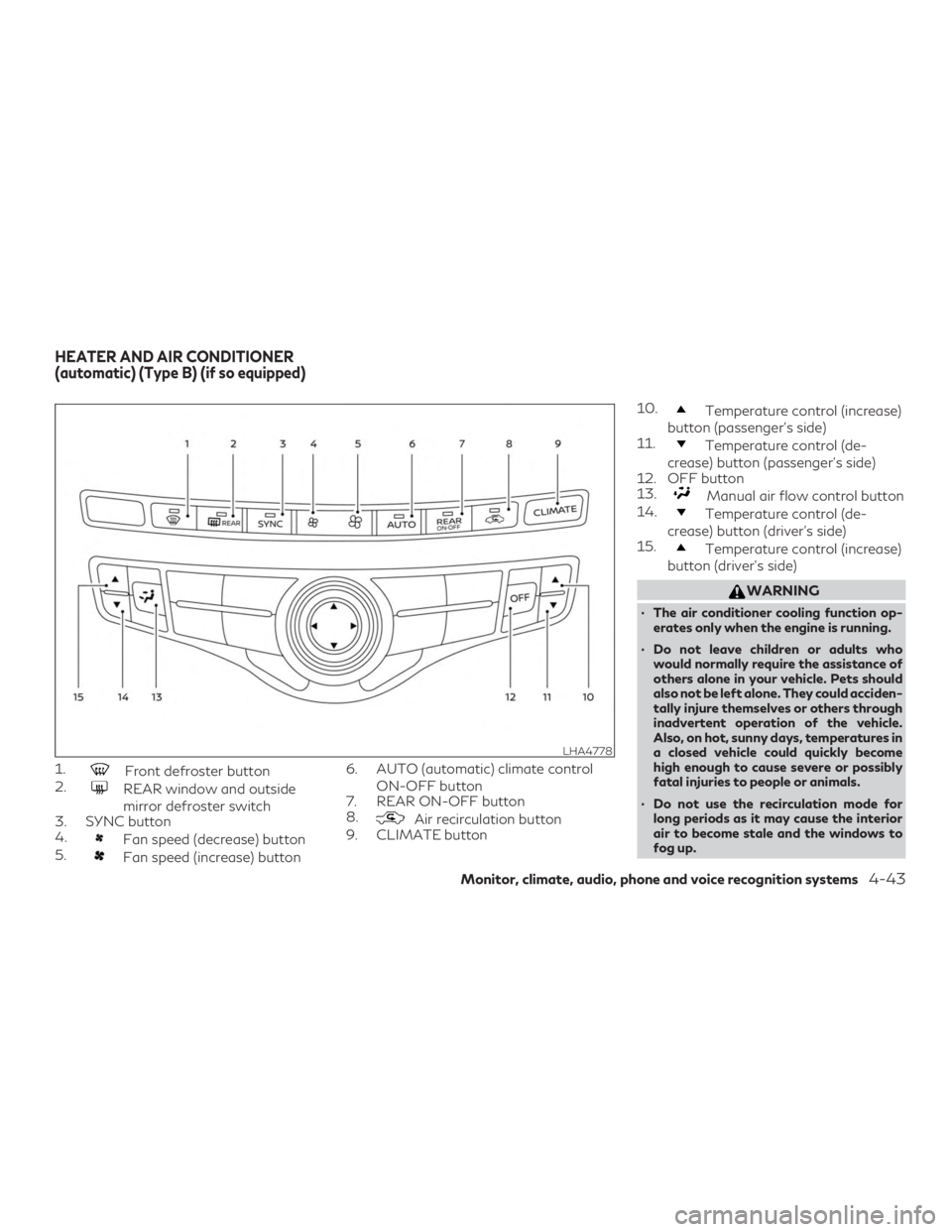
1.Front defroster button
2.
REAR window and outside
mirror defroster switch
3. SYNC button
4.
Fan speed (decrease) button
5.
Fan speed (increase) button 6. AUTO (automatic) climate control
ON-OFF button
7. REAR ON-OFF button
8.
Air recirculation button
9. CLIMATE button 10.
Temperature control (increase)
button (passenger’s side)
11.
Temperature control (de-
crease) button (passenger’s side)
12. OFF button
13.
Manual air flow control button
14.
Temperature control (de-
crease) button (driver’s side)
15.
Temperature control (increase)
button (driver’s side)
WARNING
∙ The air conditioner cooling function op- erates only when the engine is running.
∙ Do not leave children or adults who would normally require the assistance of
others alone in your vehicle. Pets should
also not be left alone. They could acciden-
tally injure themselves or others through
inadvertent operation of the vehicle.
Also, on hot, sunny days, temperatures in
a closed vehicle could quickly become
high enough to cause severe or possibly
fatal injuries to people or animals.
∙ Do not use the recirculation mode for long periods as it may cause the interior
air to become stale and the windows to
fog up.
LHA4778
HEATER AND AIR CONDITIONER
(automatic) (Type B) (if so equipped)
Monitor, climate, audio, phone and voice recognition systems4-43
Page 254 of 540
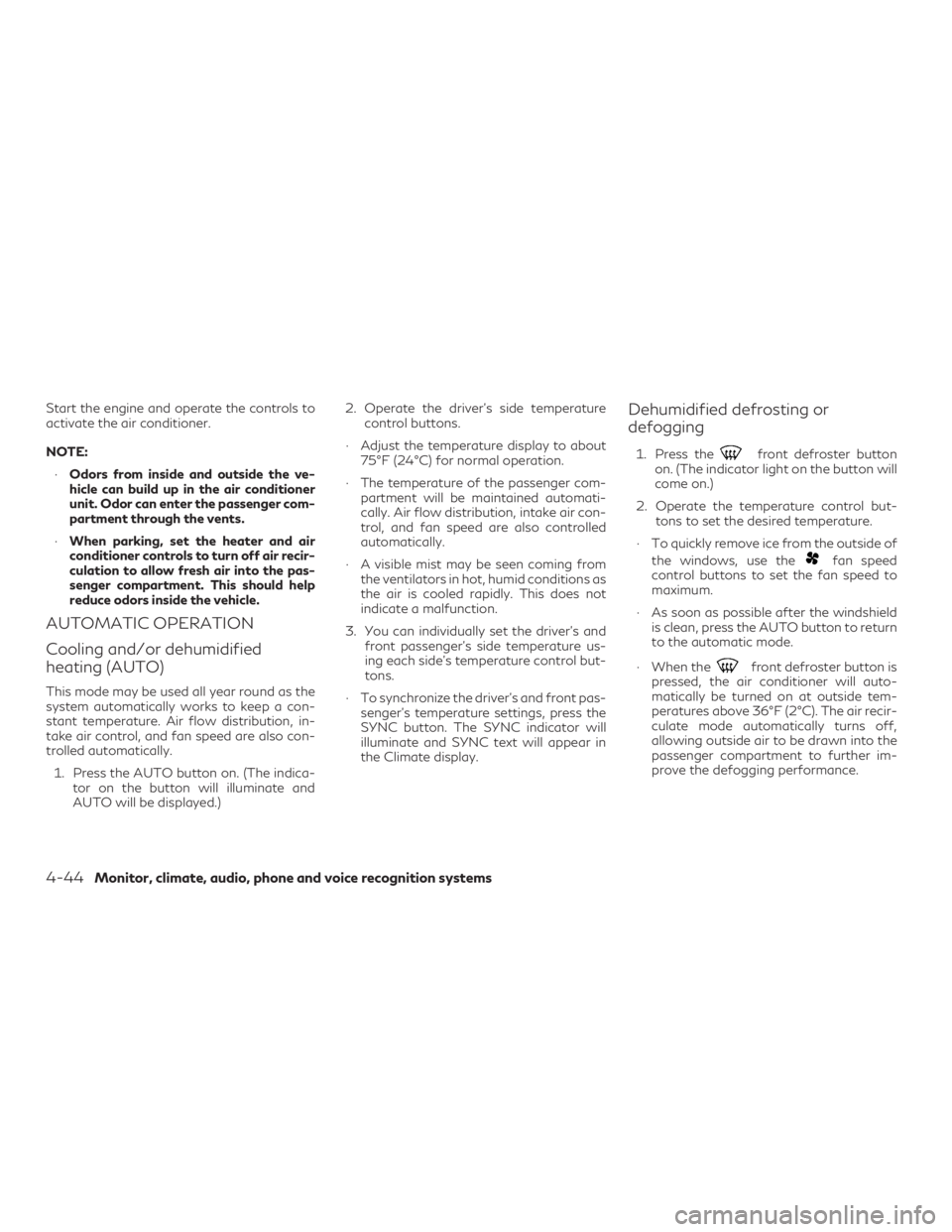
Start the engine and operate the controls to
activate the air conditioner.
NOTE:∙ Odors from inside and outside the ve-
hicle can build up in the air conditioner
unit. Odor can enter the passenger com-
partment through the vents.
∙ When parking, set the heater and air
conditioner controls to turn off air recir-
culation to allow fresh air into the pas-
senger compartment. This should help
reduce odors inside the vehicle.
AUTOMATIC OPERATION
Cooling and/or dehumidified
heating (AUTO)
This mode may be used all year round as the
system automatically works to keep a con-
stant temperature. Air flow distribution, in-
take air control, and fan speed are also con-
trolled automatically.
1. Press the AUTO button on. (The indica- tor on the button will illuminate and
AUTO will be displayed.) 2. Operate the driver’s side temperature
control buttons.
∙ Adjust the temperature display to about 75°F (24°C) for normal operation.
∙ The temperature of the passenger com- partment will be maintained automati-
cally. Air flow distribution, intake air con-
trol, and fan speed are also controlled
automatically.
∙ A visible mist may be seen coming from the ventilators in hot, humid conditions as
the air is cooled rapidly. This does not
indicate a malfunction.
3. You can individually set the driver’s and front passenger’s side temperature us-
ing each side’s temperature control but-
tons.
∙ To synchronize the driver’s and front pas- senger’s temperature settings, press the
SYNC button. The SYNC indicator will
illuminate and SYNC text will appear in
the Climate display.
Dehumidified defrosting or
defogging
1. Press thefront defroster button
on. (The indicator light on the button will
come on.)
2. Operate the temperature control but- tons to set the desired temperature.
∙ To quickly remove ice from the outside of the windows, use the
fan speed
control buttons to set the fan speed to
maximum.
∙ As soon as possible after the windshield is clean, press the AUTO button to return
to the automatic mode.
∙ When the
front defroster button is
pressed, the air conditioner will auto-
matically be turned on at outside tem-
peratures above 36°F (2°C). The air recir-
culate mode automatically turns off,
allowing outside air to be drawn into the
passenger compartment to further im-
prove the defogging performance.
4-44Monitor, climate, audio, phone and voice recognition systems
Page 255 of 540
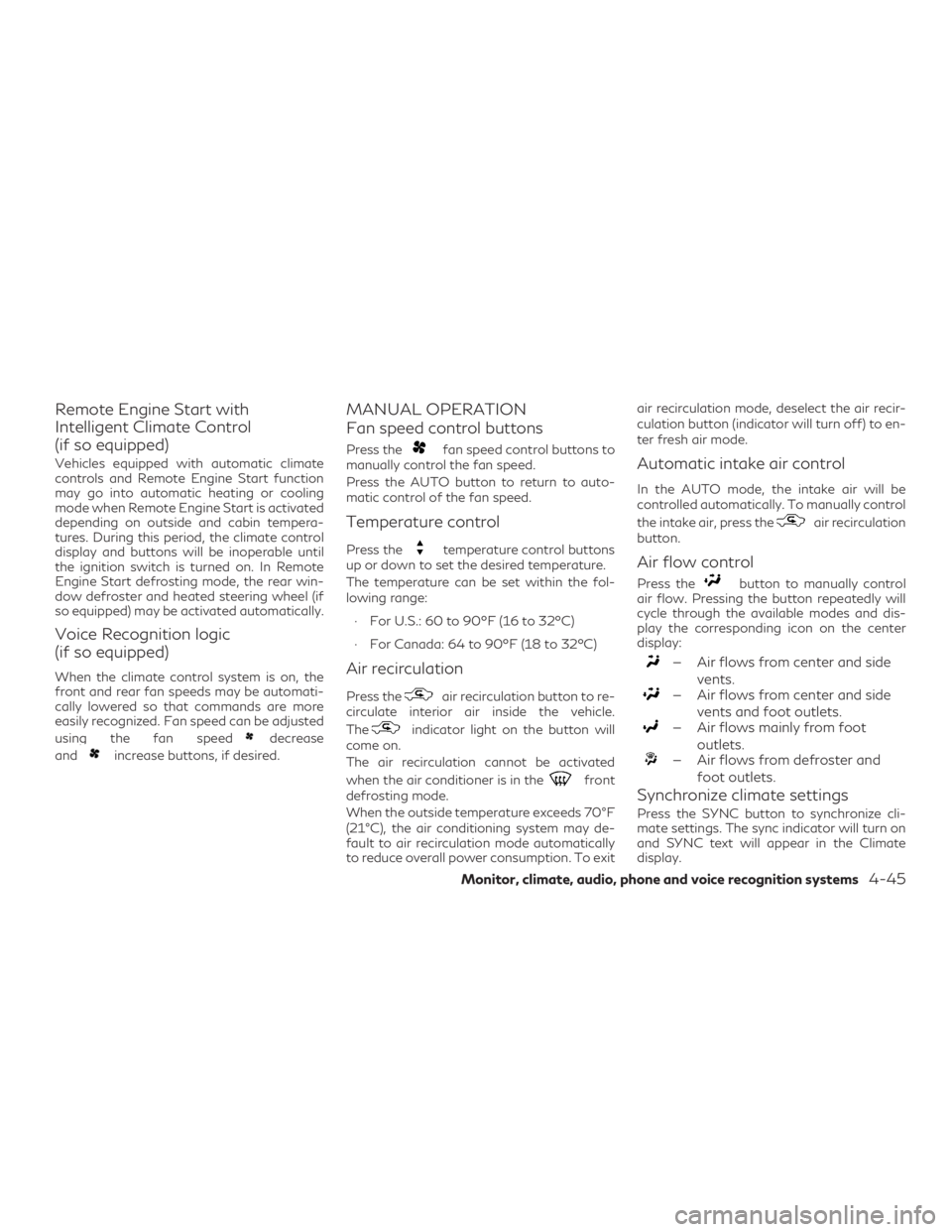
Remote Engine Start with
Intelligent Climate Control
(if so equipped)
Vehicles equipped with automatic climate
controls and Remote Engine Start function
may go into automatic heating or cooling
mode when Remote Engine Start is activated
depending on outside and cabin tempera-
tures. During this period, the climate control
display and buttons will be inoperable until
the ignition switch is turned on. In Remote
Engine Start defrosting mode, the rear win-
dow defroster and heated steering wheel (if
so equipped) may be activated automatically.
Voice Recognition logic
(if so equipped)
When the climate control system is on, the
front and rear fan speeds may be automati-
cally lowered so that commands are more
easily recognized. Fan speed can be adjusted
using the fan speed
decrease
and
increase buttons, if desired.
MANUAL OPERATION
Fan speed control buttons
Press thefan speed control buttons to
manually control the fan speed.
Press the AUTO button to return to auto-
matic control of the fan speed.
Temperature control
Press thetemperature control buttons
up or down to set the desired temperature.
The temperature can be set within the fol-
lowing range:
∙ For U.S.: 60 to 90ºF (16 to 32ºC)
∙ For Canada: 64 to 90ºF (18 to 32ºC)
Air recirculation
Press theair recirculation button to re-
circulate interior air inside the vehicle.
The
indicator light on the button will
come on.
The air recirculation cannot be activated
when the air conditioner is in the
front
defrosting mode.
When the outside temperature exceeds 70°F
(21°C), the air conditioning system may de-
fault to air recirculation mode automatically
to reduce overall power consumption. To exit air recirculation mode, deselect the air recir-
culation button (indicator will turn off) to en-
ter fresh air mode.
Automatic intake air control
In the AUTO mode, the intake air will be
controlled automatically. To manually control
the intake air, press the
air recirculation
button.
Air flow control
Press thebutton to manually control
air flow. Pressing the button repeatedly will
cycle through the available modes and dis-
play the corresponding icon on the center
display:
— Air flows from center and side
vents.
— Air flows from center and sidevents and foot outlets.
— Air flows mainly from footoutlets.
— Air flows from defroster andfoot outlets.
Synchronize climate settings
Press the SYNC button to synchronize cli-
mate settings. The sync indicator will turn on
and SYNC text will appear in the Climate
display.
Monitor, climate, audio, phone and voice recognition systems4-45
Page 257 of 540
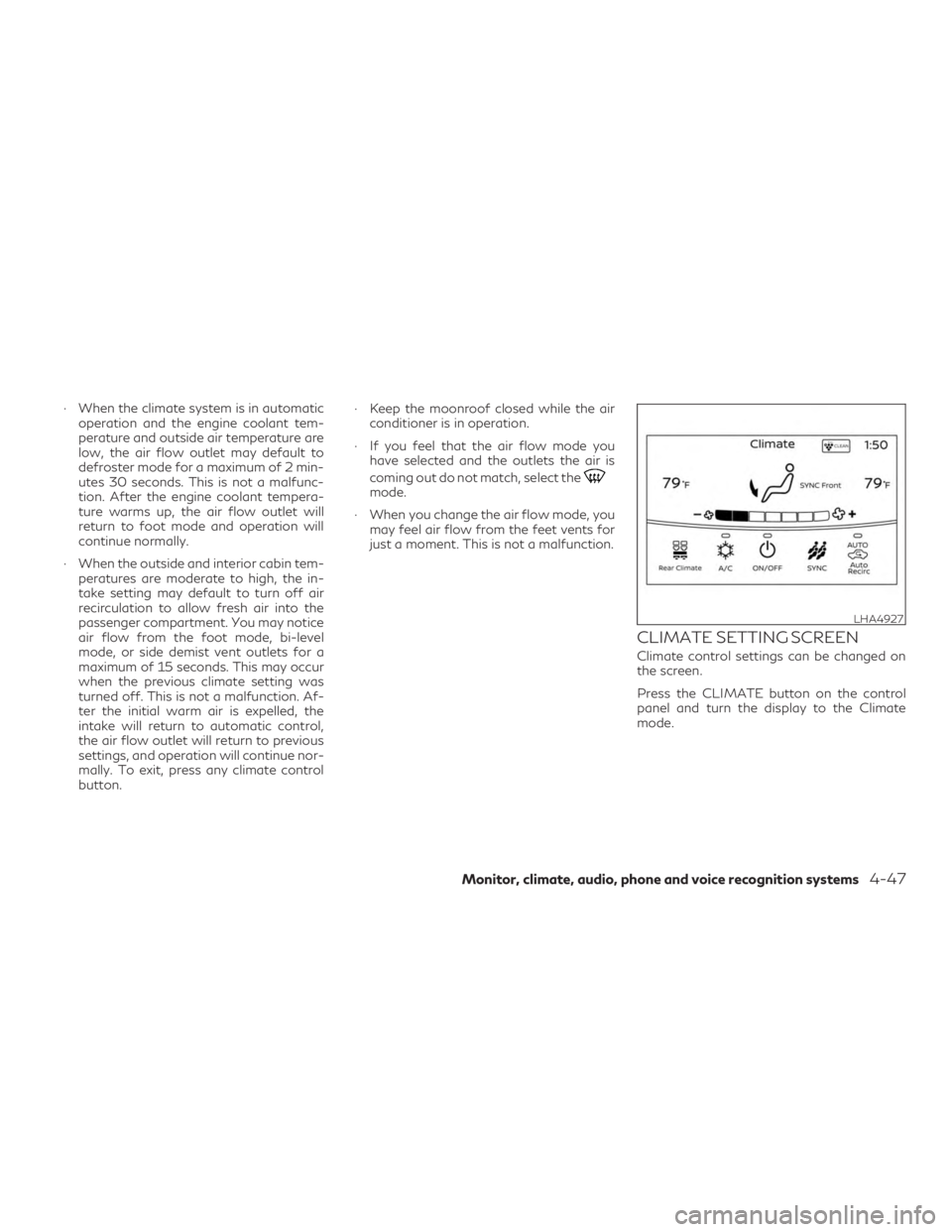
∙ When the climate system is in automaticoperation and the engine coolant tem-
perature and outside air temperature are
low, the air flow outlet may default to
defroster mode for a maximum of 2 min-
utes 30 seconds. This is not a malfunc-
tion. After the engine coolant tempera-
ture warms up, the air flow outlet will
return to foot mode and operation will
continue normally.
∙ When the outside and interior cabin tem- peratures are moderate to high, the in-
take setting may default to turn off air
recirculation to allow fresh air into the
passenger compartment. You may notice
air flow from the foot mode, bi-level
mode, or side demist vent outlets for a
maximum of 15 seconds. This may occur
when the previous climate setting was
turned off. This is not a malfunction. Af-
ter the initial warm air is expelled, the
intake will return to automatic control,
the air flow outlet will return to previous
settings, and operation will continue nor-
mally. To exit, press any climate control
button. ∙ Keep the moonroof closed while the air
conditioner is in operation.
∙ If you feel that the air flow mode you have selected and the outlets the air is
coming out do not match, select the
mode.
∙ When you change the air flow mode, you may feel air flow from the feet vents for
just a moment. This is not a malfunction.
CLIMATE SETTING SCREEN
Climate control settings can be changed on
the screen.
Press the CLIMATE button on the control
panel and turn the display to the Climate
mode.
LHA4927
Monitor, climate, audio, phone and voice recognition systems4-47
Page 264 of 540
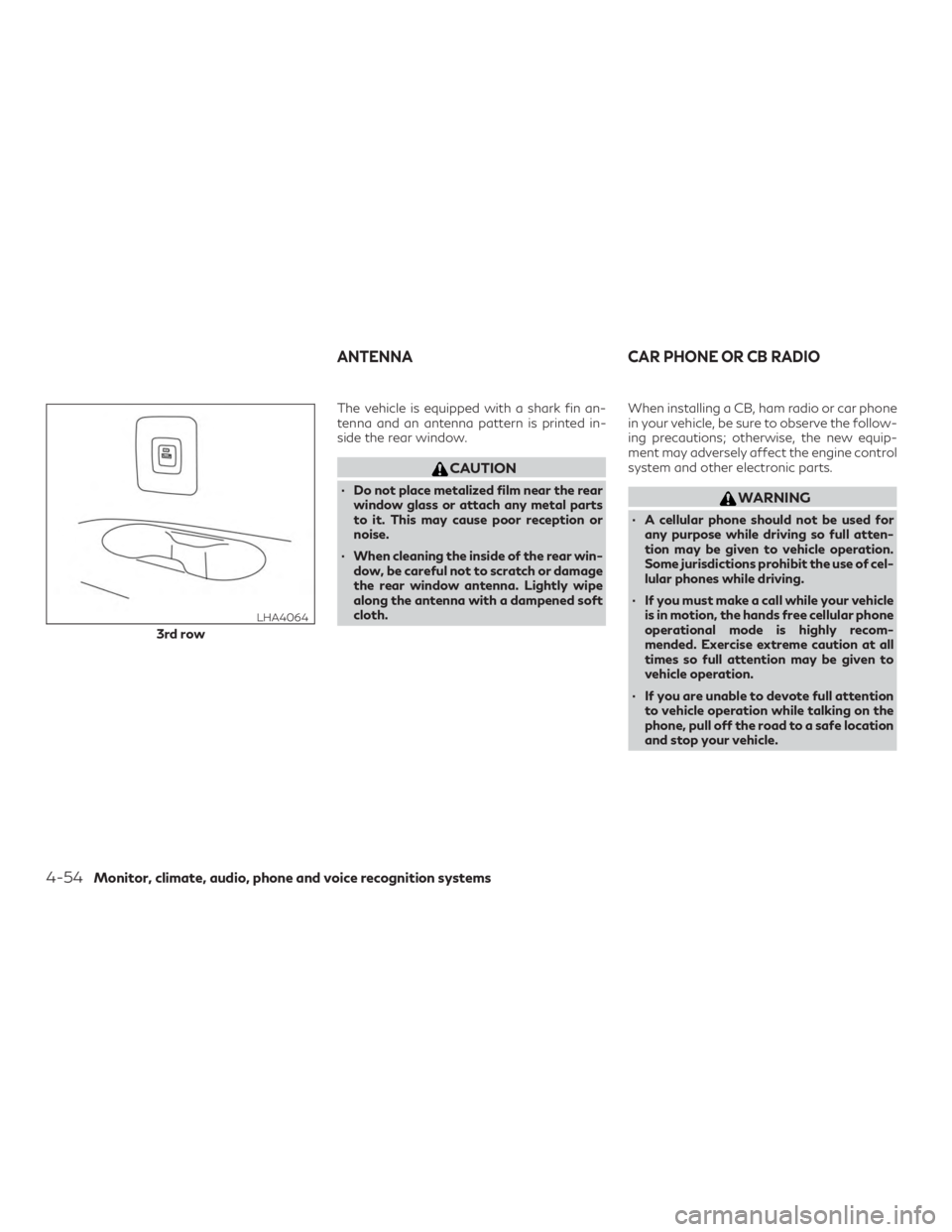
The vehicle is equipped with a shark fin an-
tenna and an antenna pattern is printed in-
side the rear window.
CAUTION
∙ Do not place metalized film near the rearwindow glass or attach any metal parts
to it. This may cause poor reception or
noise.
∙ When cleaning the inside of the rear win- dow, be careful not to scratch or damage
the rear window antenna. Lightly wipe
along the antenna with a dampened soft
cloth. When installing a CB, ham radio or car phone
in your vehicle, be sure to observe the follow-
ing precautions; otherwise, the new equip-
ment may adversely affect the engine control
system and other electronic parts.WARNING
∙ A cellular phone should not be used for
any purpose while driving so full atten-
tion may be given to vehicle operation.
Some jurisdictions prohibit the use of cel-
lular phones while driving.
∙ If you must make a call while your vehicle is in motion, the hands free cellular phone
operational mode is highly recom-
mended. Exercise extreme caution at all
times so full attention may be given to
vehicle operation.
∙ If you are unable to devote full attention to vehicle operation while talking on the
phone, pull off the road to a safe location
and stop your vehicle.
3rd row
LHA4064
ANTENNA CAR PHONE OR CB RADIO
4-54Monitor, climate, audio, phone and voice recognition systems
Page 267 of 540
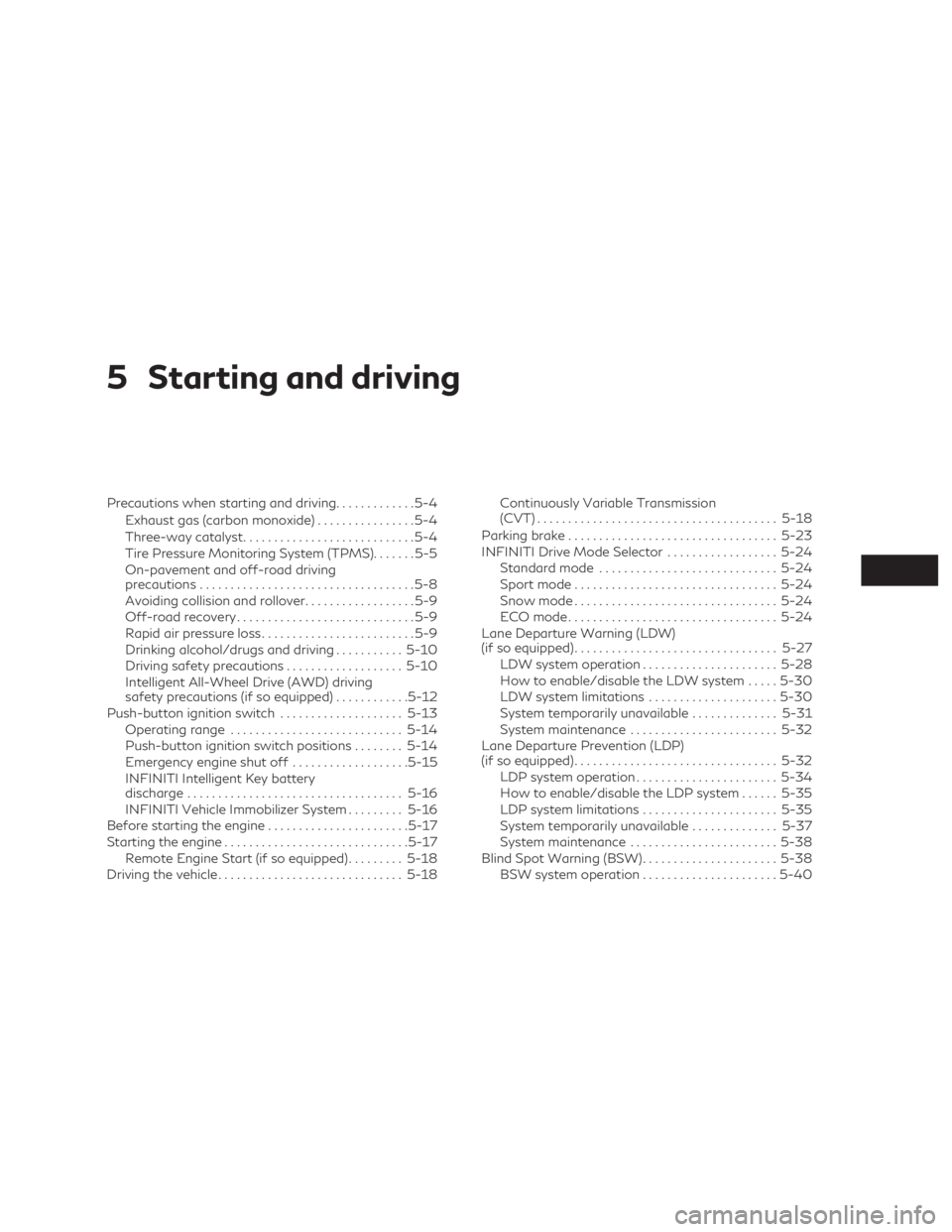
5 Starting and driving
Precautions when starting and driving.............5-4
Exhaust gas (carbon monoxide) ................5-4
Three-way catalyst ............................5-4
Tire Pressure Monitoring System (TPMS) .......5-5
On-pavement and off-road driving
precautions ...................................5-8
Avoiding collision and rollover ..................5-9
Off-road recovery .............................5-9
Rapid air pressure loss .........................5-9
Drinking alcohol/drugs and driving ...........5-10
Driving safety precautions ...................5-10
Intelligent All-Wheel Drive (AWD) driving
safety precautions (if so equipped) ............5-12
Push-button ignition switch ....................5-13
Operating range ............................ 5-14
Push-button ignition switch positions ........5-14
Emergency engine shut off ...................5-15
INFINITI Intelligent Key battery
discharge ................................... 5-16
INFINITI Vehicle Immobilizer System .........5-16
Before starting the engine .......................5-17
Starting the engine .............................. 5-17
Remote Engine Start (if so equipped) .........5-18
Driving the vehicle .............................. 5-18Continuously Variable Transmission
(CVT)
....................................... 5-18
Parking brake .................................. 5-23
INFINITI Drive Mode Selector ..................5-24
Standard mode ............................. 5-24
Sport mode ................................. 5-24
Snow mode ................................. 5-24
ECO mode .................................. 5-24
Lane Departure Warning (LDW)
(if so equipped) ................................. 5-27
LDW system operation ......................5-28
How to enable/disable the LDW system .....5-30
LDW system limitations .....................5-30
System temporarily unavailable ..............5-31
System maintenance ........................ 5-32
Lane Departure Prevention (LDP)
(if so equipped) ................................. 5-32
L D
P system operation ....................... 5-34
How to enable/disable the LDP system ......5-35
LDP system limitations ......................5-35
System temporarily unavailable ..............5-37
System maintenance ........................ 5-38
Blind Spot Warning (BSW) ......................5-38
BSW system operation ......................5-40
Page 269 of 540
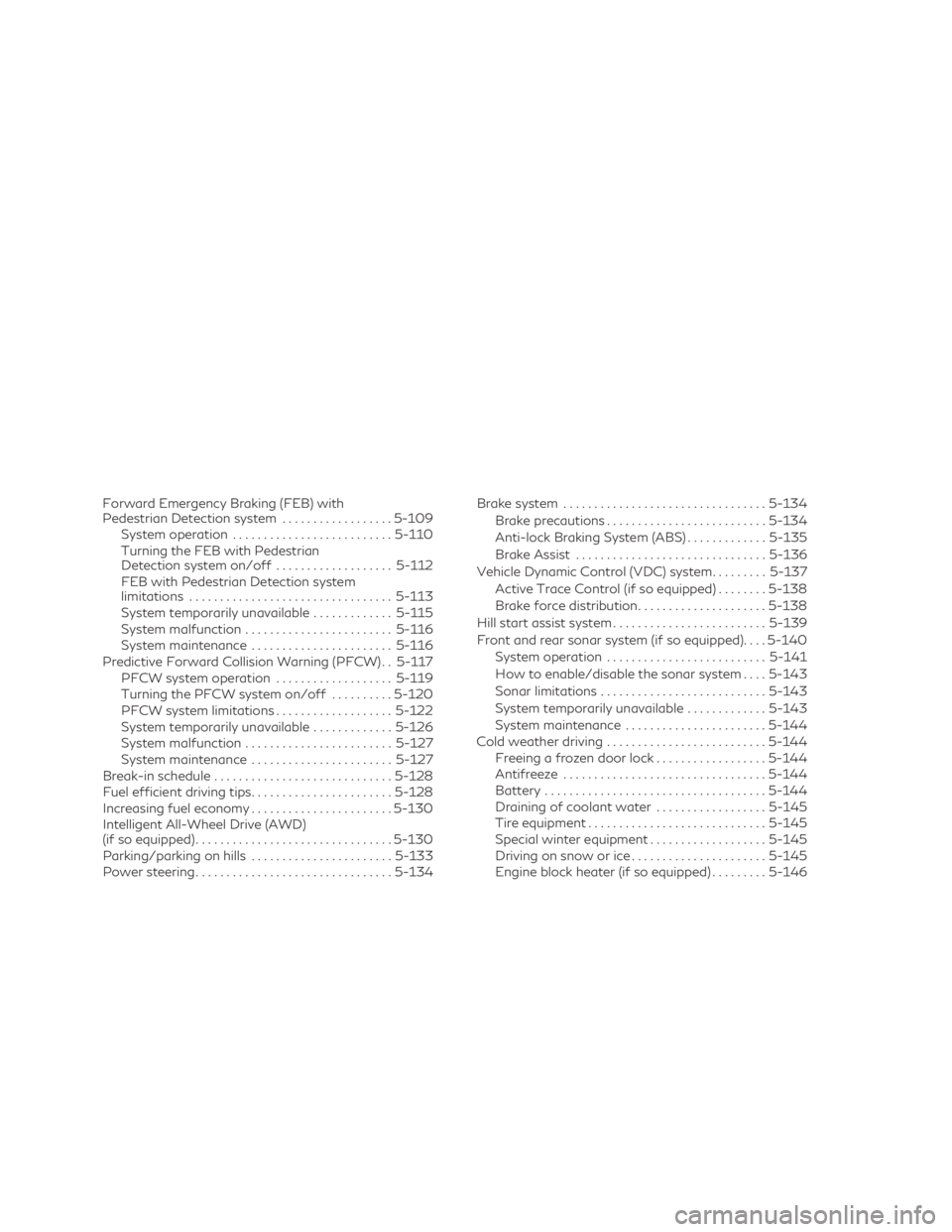
Forward Emergency Braking (FEB) with
Pedestrian Detection system..................5-109
System operation .......................... 5-110
Turning the FEB with Pedestrian
Detection system on/off ...................5-112
FEB with Pedestrian Detection system
limitations ................................. 5-113
System temporarily unavailable .............5-115
System malfunction ........................ 5-116
System maintenance ....................... 5-116
Predictive Forward Collision Warning (PFCW) . . 5-117 PFCW system operation ...................5-119
Turning the PFCW system on/off ..........5-120
PFCW system limitations ...................5-122
System temporarily unavailable .............5-126
System malfunction ........................ 5-127
System maintenance ....................... 5-127
Break-in schedule ............................. 5-128
Fuel efficient driving tips .......................5-128
Increasing fuel economy .......................5-130
Intelligent All-Wheel Drive (AWD)
(if so equipped) ................................ 5-130
Parking/parking on hills .......................5-133
Power steering ................................ 5-134Brake system
................................. 5-134
Brake precautions .......................... 5-134
Anti-lock Braking System (ABS) .............5-135
Brake Assist ............................... 5-136
Vehicle Dynamic Control (VDC) system .........5-137
Active Trace Control (if so equipped) ........5-138
Brake force distribution .....................5-138
Hill start assist system ......................... 5-139
Front and rear sonar system (if so equipped) ....5-140
System operation .......................... 5-141
How to enable/disable the sonar system ....5-143
Sonar limitations ........................... 5-143
System temporarily unavailable .............5-143
System maintenance ....................... 5-144
Cold weather
driving.......................... 5-144
Freeing a frozen door lock ..................5-144
Antifreeze ................................. 5-144
Battery .................................... 5-144
Draining of coolant water ..................5-145
Tire equipment ............................. 5-145
Special winter equipment ...................5-145
Driving on snow or ice ...................... 5-145
Engine block heater (if so equipped) .........5-146
Page 270 of 540
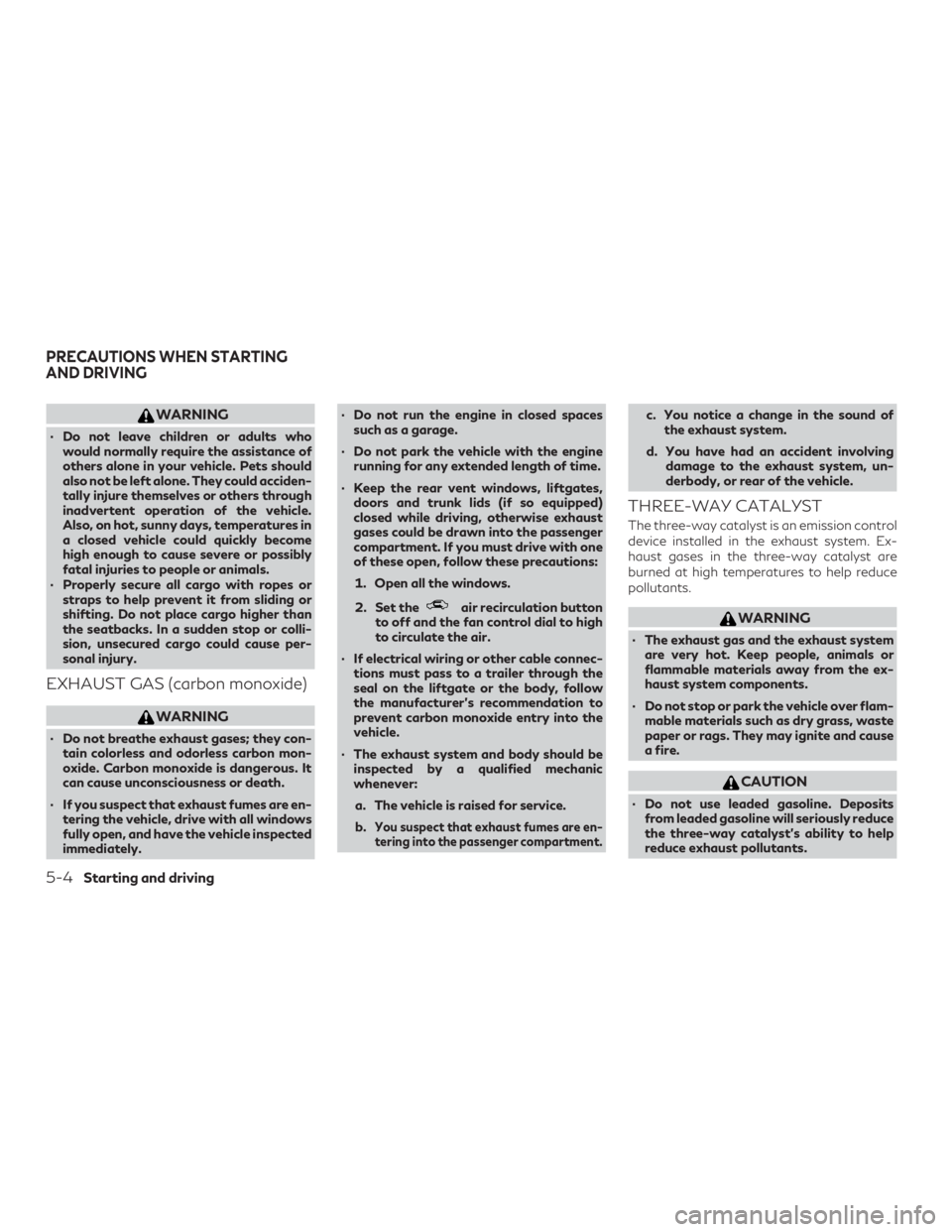
WARNING
∙ Do not leave children or adults whowould normally require the assistance of
others alone in your vehicle. Pets should
also not be left alone. They could acciden-
tally injure themselves or others through
inadvertent operation of the vehicle.
Also, on hot, sunny days, temperatures in
a closed vehicle could quickly become
high enough to cause severe or possibly
fatal injuries to people or animals.
∙ Properly secure all cargo with ropes or straps to help prevent it from sliding or
shifting. Do not place cargo higher than
the seatbacks. In a sudden stop or colli-
sion, unsecured cargo could cause per-
sonal injury.
EXHAUST GAS (carbon monoxide)
WARNING
∙ Do not breathe exhaust gases; they con-tain colorless and odorless carbon mon-
oxide. Carbon monoxide is dangerous. It
can cause unconsciousness or death.
∙ If you suspect that exhaust fumes are en- tering the vehicle, drive with all windows
fully open, and have the vehicle inspected
immediately. ∙ Do not run the engine in closed spaces
such as a garage.
∙ Do not park the vehicle with the engine running for any extended length of time.
∙ Keep the rear vent windows, liftgates, doors and trunk lids (if so equipped)
closed while driving, otherwise exhaust
gases could be drawn into the passenger
compartment. If you must drive with one
of these open, follow these precautions:
1. Open all the windows.
2. Set the
air recirculation button
to off and the fan control dial to high
to circulate the air.
∙ If electrical wiring or other cable connec- tions must pass to a trailer through the
seal on the liftgate or the body, follow
the manufacturer’s recommendation to
prevent carbon monoxide entry into the
vehicle.
∙ The exhaust system and body should be inspected by a qualified mechanic
whenever:
a. The vehicle is raised for service.
b.
You suspect that exhaust fumes are en-
tering into the passenger compartment.
c. You notice a change in the sound of the exhaust system.
d. You have had an accident involving damage to the exhaust system, un-
derbody, or rear of the vehicle.
THREE-WAY CATALYST
The three-way catalyst is an emission control
device installed in the exhaust system. Ex-
haust gases in the three-way catalyst are
burned at high temperatures to help reduce
pollutants.
WARNING
∙ The exhaust gas and the exhaust systemare very hot. Keep people, animals or
flammable materials away from the ex-
haust system components.
∙ Do not stop or park the vehicle over flam- mable materials such as dry grass, waste
paper or rags. They may ignite and cause
a fire.
CAUTION
∙ Do not use leaded gasoline. Depositsfrom leaded gasoline will seriously reduce
the three-way catalyst’s ability to help
reduce exhaust pollutants.
PRECAUTIONS WHEN STARTING
AND DRIVING
5-4Starting and driving
Page 271 of 540
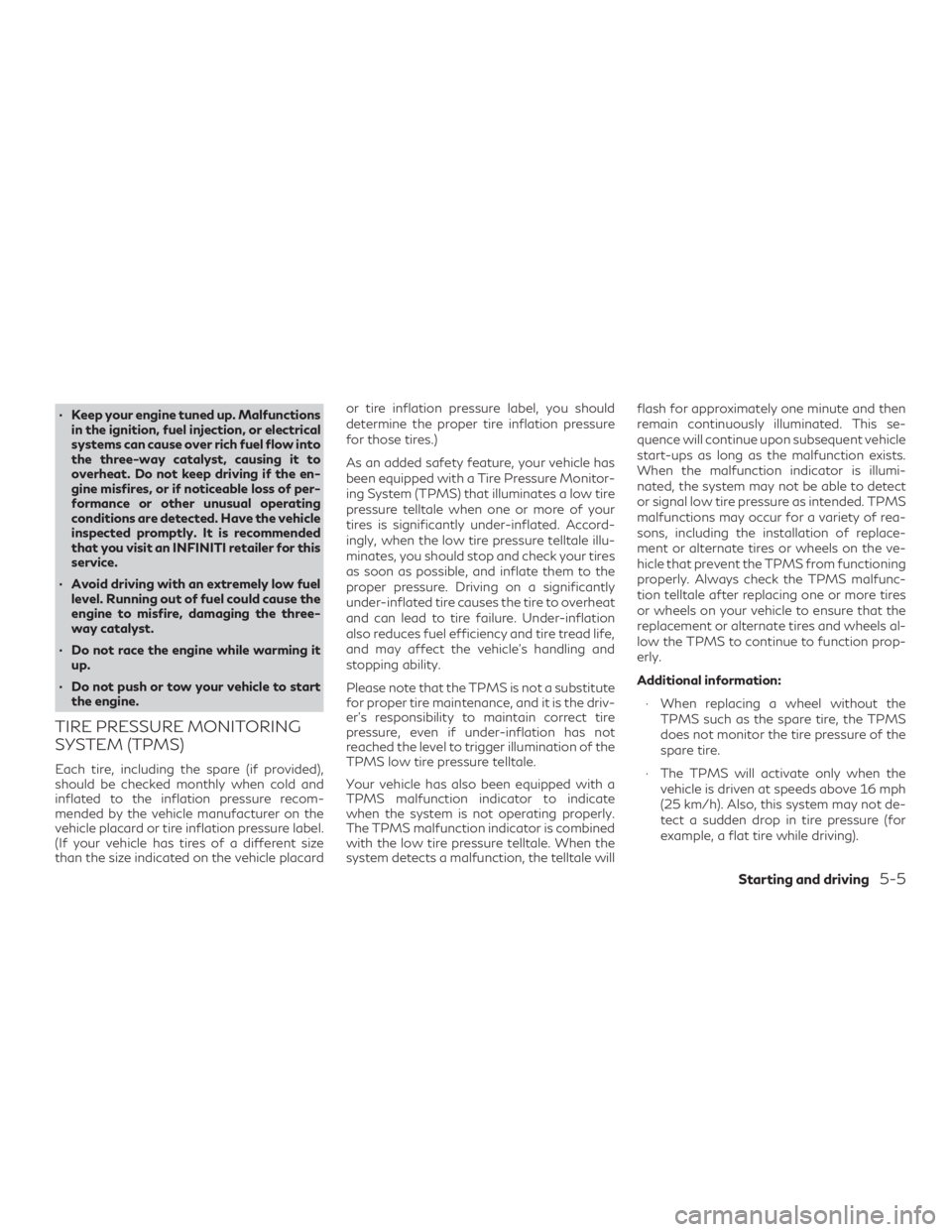
∙ Keep your engine tuned up. Malfunctionsin the ignition, fuel injection, or electrical
systems can cause over rich fuel flow into
the three-way catalyst, causing it to
overheat. Do not keep driving if the en-
gine misfires, or if noticeable loss of per-
formance or other unusual operating
conditions are detected. Have the vehicle
inspected promptly. It is recommended
that you visit an INFINITI retailer for this
service.
∙ Avoid driving with an extremely low fuel level. Running out of fuel could cause the
engine to misfire, damaging the three-
way catalyst.
∙ Do not race the engine while warming it up.
∙ Do not push or tow your vehicle to start the engine.
TIRE PRESSURE MONITORING
SYSTEM (TPMS)
Each tire, including the spare (if provided),
should be checked monthly when cold and
inflated to the inflation pressure recom-
mended by the vehicle manufacturer on the
vehicle placard or tire inflation pressure label.
(If your vehicle has tires of a different size
than the size indicated on the vehicle placard or tire inflation pressure label, you should
determine the proper tire inflation pressure
for those tires.)
As an added safety feature, your vehicle has
been equipped with a Tire Pressure Monitor-
ing System (TPMS) that illuminates a low tire
pressure telltale when one or more of your
tires is significantly under-inflated. Accord-
ingly, when the low tire pressure telltale illu-
minates, you should stop and check your tires
as soon as possible, and inflate them to the
proper pressure. Driving on a significantly
under-inflated tire causes the tire to overheat
and can lead to tire failure. Under-inflation
also reduces fuel efficiency and tire tread life,
and may affect the vehicle’s handling and
stopping ability.
Please note that the TPMS is not a substitute
for proper tire maintenance, and it is the driv-
er’s responsibility to maintain correct tire
pressure, even if under-inflation has not
reached the level to trigger illumination of the
TPMS low tire pressure telltale.
Your vehicle has also been equipped with a
TPMS malfunction indicator to indicate
when the system is not operating properly.
The TPMS malfunction indicator is combined
with the low tire pressure telltale. When the
system detects a malfunction, the telltale willflash for approximately one minute and then
remain continuously illuminated. This se-
quence will continue upon subsequent vehicle
start-ups as long as the malfunction exists.
When the malfunction indicator is illumi-
nated, the system may not be able to detect
or signal low tire pressure as intended. TPMS
malfunctions may occur for a variety of rea-
sons, including the installation of replace-
ment or alternate tires or wheels on the ve-
hicle that prevent the TPMS from functioning
properly. Always check the TPMS malfunc-
tion telltale after replacing one or more tires
or wheels on your vehicle to ensure that the
replacement or alternate tires and wheels al-
low the TPMS to continue to function prop-
erly.
Additional information:
∙ When replacing a wheel without the TPMS such as the spare tire, the TPMS
does not monitor the tire pressure of the
spare tire.
∙ The TPMS will activate only when the vehicle is driven at speeds above 16 mph
(25 km/h). Also, this system may not de-
tect a sudden drop in tire pressure (for
example, a flat tire while driving).
Starting and driving5-5
Page 274 of 540
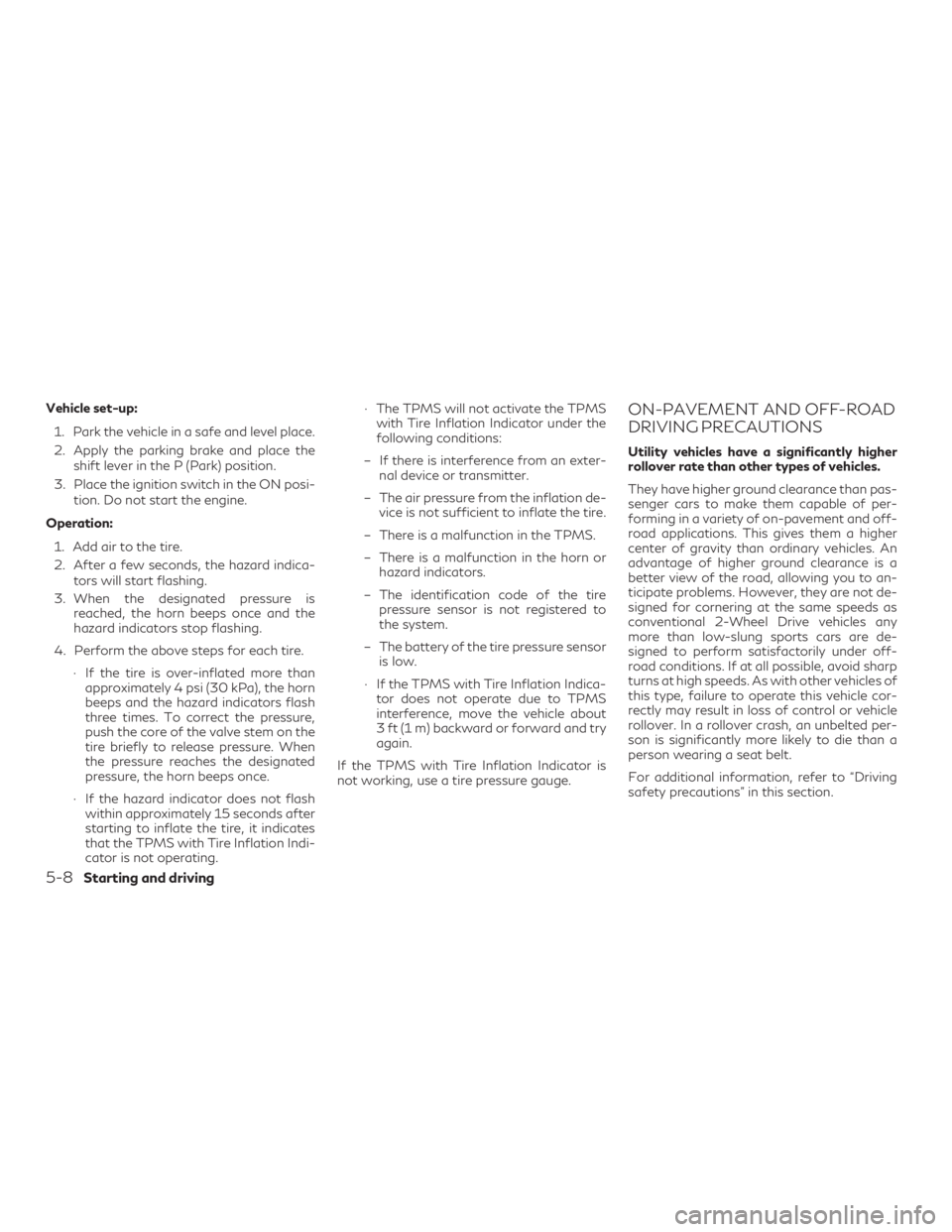
Vehicle set-up:1. Park the vehicle in a safe and level place.
2. Apply the parking brake and place the shift lever in the P (Park) position.
3. Place the ignition switch in the ON posi- tion. Do not start the engine.
Operation: 1. Add air to the tire.
2. After a few seconds, the hazard indica- tors will start flashing.
3. When the designated pressure is reached, the horn beeps once and the
hazard indicators stop flashing.
4. Perform the above steps for each tire. ∙ If the tire is over-inflated more thanapproximately 4 psi (30 kPa), the horn
beeps and the hazard indicators flash
three times. To correct the pressure,
push the core of the valve stem on the
tire briefly to release pressure. When
the pressure reaches the designated
pressure, the horn beeps once.
∙ If the hazard indicator does not flash within approximately 15 seconds after
starting to inflate the tire, it indicates
that the TPMS with Tire Inflation Indi-
cator is not operating. ∙ The TPMS will not activate the TPMS
with Tire Inflation Indicator under the
following conditions:
– If there is interference from an exter- nal device or transmitter.
– The air pressure from the inflation de- vice is not sufficient to inflate the tire.
– There is a malfunction in the TPMS.
– There is a malfunction in the horn or hazard indicators.
– The identification code of the tire pressure sensor is not registered to
the system.
– The battery of the tire pressure sensor is low.
∙ If the TPMS with Tire Inflation Indica- tor does not operate due to TPMS
interference, move the vehicle about
3 ft (1 m) backward or forward and try
again.
If the TPMS with Tire Inflation Indicator is
not working, use a tire pressure gauge.ON-PAVEMENT AND OFF-ROAD
DRIVING PRECAUTIONS
Utility vehicles have a significantly higher
rollover rate than other types of vehicles.
They have higher ground clearance than pas-
senger cars to make them capable of per-
forming in a variety of on-pavement and off-
road applications. This gives them a higher
center of gravity than ordinary vehicles. An
advantage of higher ground clearance is a
better view of the road, allowing you to an-
ticipate problems. However, they are not de-
signed for cornering at the same speeds as
conventional 2-Wheel Drive vehicles any
more than low-slung sports cars are de-
signed to perform satisfactorily under off-
road conditions. If at all possible, avoid sharp
turns at high speeds. As with other vehicles of
this type, failure to operate this vehicle cor-
rectly may result in loss of control or vehicle
rollover. In a rollover crash, an unbelted per-
son is significantly more likely to die than a
person wearing a seat belt.
For additional information, refer to “Driving
safety precautions” in this section.
5-8Starting and driving